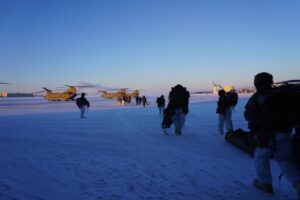The Army on Tuesday released its new Arctic strategy calling for establishing a two-star headquarters in the region with specially-equipped combat brigades and delivering new capabilities to bolster operations in harsher cold-weather, mountainous conditions.
The new document specifically highlights a need for an improved cold-weather all-terrain vehicle, new power generation systems, unmanned technologies and space-based communications systems to support future Arctic units.

“The Arctic is an opportunity to rapidly employ the speed, range and convergence of cutting-edge technologies being developed for Multi-Domain Operations to strengthen our deterrence capabilities in the region,” Gen. James McConville, the Army chief of staff, said in a statement announcing the new strategy.
Army officials cite Russian military developments in the region as “the most advanced driver of great power competition” and say China is using the Arctic as “a new strategic frontier” that will require greater U.S. “presence in the high North.”
“The Arctic has the potential to become a contested space where the United States’ great power rivals, Russia and China, seek to use military and economic power to gain and maintain access to the region at the expense of US interests,” the Army writes in its strategy.
The new strategy builds on the DoD’s 2019 Arctic plan, and follows an Air Force strategy last July and a Navy-published strategic outlook in 2019. The Coast Guard also has an Arctic strategy.
To begin the Arctic focus, the Army plans to station one of its new long range fires-enabled Multi-Domain Task Forces (MDTF) in the region which it says will be required for “an area of operations characterized by vast distances and where air and naval avenues of approach are critical.”
“The Army’s decision to place an MDTF in Alaska is the first step in setting the conditions for success,” the service writes. “In Alaska, it will have the ability to take advantage of world class training facilities and the presence of significant U.S. Air Force and U.S. Navy forces to experiment and train multi-domain operations.”
For future capabilities, the Army said it must ensure all Arctic units are equipped with systems that can function at temperatures down to negative 65 degrees Fahrenheit and it will examine new power generation systems along with the joint services.
“Power generation in the Arctic is a significant challenge due to vast distances, extreme temperatures, and inadequate sustainment infrastructure,” the Army wrote. “The Army, in working with the other Services and Department, will examine ways to make improvements through use of alternative technologies that can improve operational effectiveness while reducing sustainment demands.”
The Army is also planning to continue exploring a replacement for its Small Unit Support Vehicles to function as a future Cold-Weather All-Terrain Vehicle for improved mobility in the Arctic environment.
Officials will look to identify a range of unmanned systems to support Arctic-based units to augment capabilities where mountainous areas or otherwise harsh environments would make mobility challenging.
“The harsh environment and extended distances and other mountainous environments in the Arctic limit manned aviation operations. As unmanned aerial systems become more functional and durable in Arctic environments, they will serve as a combat multiplier in our ability to project capabilities within the region,” the Army wrote.
The Army is also expecting to advocate for space-based communications to enhance communications and data coverage, along with building terrestrial-based retransmission sites in the Arctic.
“Satellite communications can assist in dispersed operations in areas with limited improved infrastructure,” the Army wrote. “The Army will work with Combatant Commands and with allies and partners to identify and advocate for ways to improve satellite communications in the Arctic to mitigate the impact of solar weather patterns on UHF communications in the Polar Regions. In the interim and as a reinforcing effort, the Army will consider building widely dispersed hard shelter communications and retransmission sites or multi-spectral communication relay towers.”